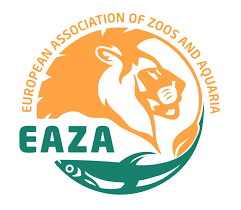
It all started in autumn of last year when pairs at our specialized centre began exhibiting signs of breeding behaviour. And since then, our staff on-site have been jumping through hoops to attain the first Bearded Vulture chick of 2022 – and the challenging work is not over yet!
Pair with a history of several unsuccessful breeding attempts
The Bearded Vulture parents of the newly hatched chick are Joseph and Marie Antoinette. Both hatched within the Bearded Vulture Captive Breeding Network, currently coordinated by us at the Vulture Conservation Foundation (VCF) on behalf of EAZA’s EEP (Bearded Vulture EEP). Joseph is a significant bird from a genetic point of view, and is also an excellent dad and partner. M. Antoinette hatched within captivity and was released in Haute Savoie back in 1998 as part of the Alpine reintroduction project. She even bred in the wild. Sadly, in 2004, she collided with a powerline and suffered serious permanent injuries that deemed her unable to live in the wild, so she joined the captive breeding programme. M. Antoinette and Joseph formed a pair but showed incubation problems, with lots of eggs breaking or disappearing in the nest.
Measures adapted improve parents’ breeding success
The pair moved to the VCF’s Bearded Vulture Specialised Breeding Unit, located within the Centre de Fauna de Vallcalent, owned by Generalitat de Catalunya, to examine the potential problem. This centre, located in Lleida, Spain, hosts the most challenging birds within the Bearded Vulture EEP. With the expertise and experience of Alex Llopis (VCF’s Vultures Captive Breeding Manager & Bearded Vulture EEP Coordinator) and the facilities at the centre, these pairs have a better chance of breeding. In 2016, Alex discovered the problem. Due to her injured leg, M. Antoinette couldn’t dig a bowl to lay her clutch, so the eggs rolled and eventually broke. Since then, the staff remove the eggs and artificially incubate them. In the nest, they place dummy eggs, which allows the pair to continue with the breeding period, which in turn, enables them to adopt a chick when the time comes (their own or some other pair’s chick). Joseph and M. Antoinette make excellent parents – they have raised seven chicks so far!
The first Bearded Vulture chick of 2022 hatches




This breeding season, M. Antoinette laid her egg on 19 December 2021 at 6:48, and at 11:00, the staff removed the egg for artificial incubation. Then, on 7 February 2022, it started hatching, and at 8:30, the chick already pecked the air cell, which means that the egg did not crack yet, but you could hear the chick chirping. Hours later, around 19:00, the chick pecked the egg’s shell, and hatched without help on 10 February during the night, around 4 am. It weighed 159.5 g and received the number BG1130. Carmen Calero, the VCF’s Bearded Vulture Captive Breeding Assistant, fed it 4 times over the first day and spent the night monitoring its temperature – everything was going smoothly. But, when she checked the centre’s cameras at 6 am, something alarming happened that required urgent action…
Emergency foster adoption by human-imprinted Bearded Vulture male
As per protocol, the initial objective was to hand-rear the chick for the first 4 to 5 days. In this way, the chick is strong enough to maintain its head up, can chirp loudly and better withstand low temperatures when the adoption by the foster parent takes place. But during the night, Kajazo, the human-imprinted Bearded Vulture male that ‘pairs’ with Alex, stopped incubating his dummy egg. This behaviour was worrying because Bearded Vulture adults need continuity during the breeding process to adopt a chick. So when Kajazo stopped incubating, we were scared that he has finished his breeding period and wouldn’t adopt the chick. We have another possible foster pair, the chick’s parents, but we need them for the chick from Torreferrusa who just hatched a couple of days ago.



So, after feeding the chick twice that morning on 11 February, we immediately made the adoption at 9:35. The chick was only 166.6 g. The situation was tense. First of all, there was a possibility that Kajazo wouldn’t accept the chick – we have to give the foster parent some time to react, but not too much, or the chick can suffer hypothermia when not brooded. Secondly, Kajazo could have reacted aggressively towards the chick, resulting in injuries or even death. We placed the chick in the nest at 9:36, and fortunately, 12 minutes later, Kajazo started brooding it. Since then, he has been a really good foster father. Both Alex and Carmen spent the weekend at the centre monitoring the chick very closely because Kajazo has never adopted such a young chick.
Alex and Carmen will continue keeping a close eye on the chick and Kajazo to ensure everything goes smoothly. We hope everything turns out well in the end!







